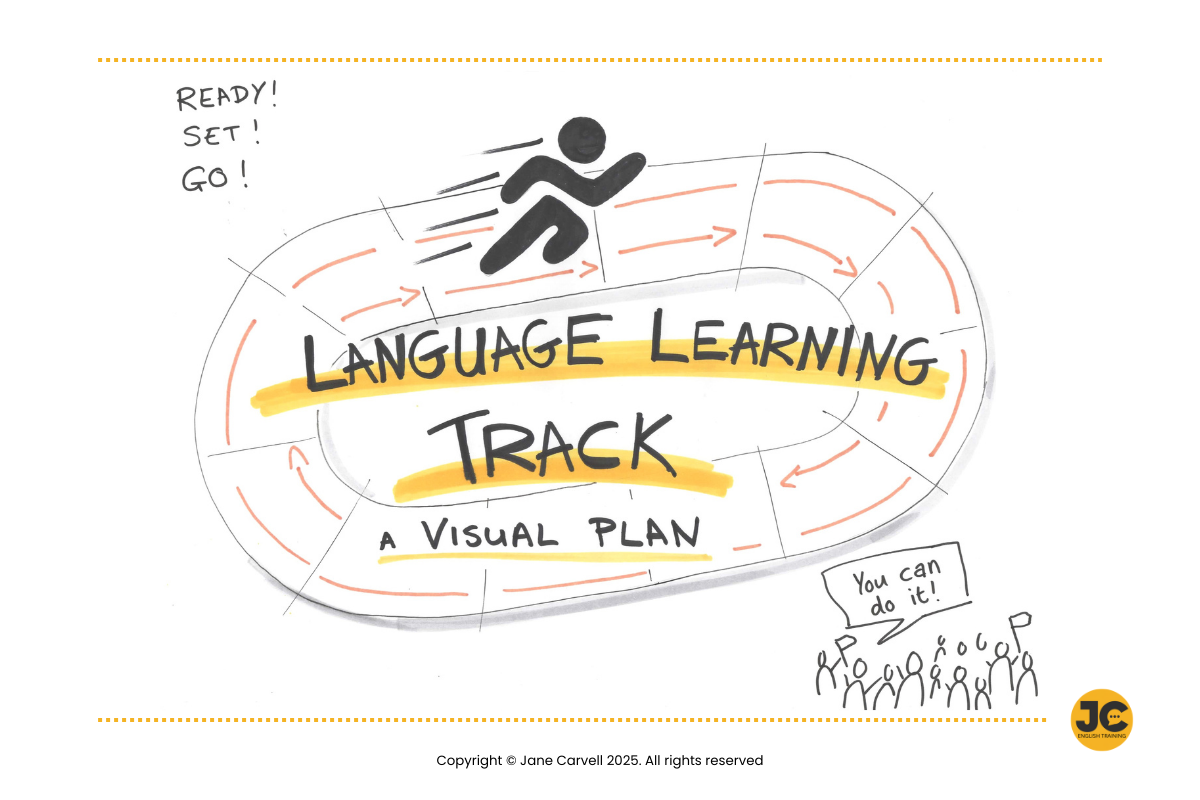The Language Learning Track: A Visual Plan for Business English Success
Read on to find out how to make a visual plan for your English training.
My work as a language coach involves supporting my clients in planning how to reach their learning goals or even defining those goals in the first place (see my post on using the GROW framework for goal setting here). Even with a clear goal, learning English (especially business English) can feel overwhelming because there are so many options available. It’s easy to feel unsure about where to start, or to lose momentum after the first burst of motivation.
You want to know which steps will help you reach your goal in the most effective and rewarding way. At the same time, you have a busy life, so it’s important to fit language learning into your schedule in a realistic way.
That’s why I’ve developed two simple visual templates for structured English learning to help you (or your team) plan your language training, stay consistent, and reach your goals.
Visual planning is a powerful tool used by professionals across different fields. For example, Team GB swimmer Adam Peaty recently shared his visual roadmap for the Paris 2024 Olympic Games on LinkedIn, highlighting how breaking down a goal into clear phases improves focus and motivation (see his post here).
Olympic swimmer, Adam Peaty’s roadmap to Paris 2024. If visual thinking works for elite athletes, it’ll be great for language learners too, right? 😊
Similarly, Cara Holland explores structured visual planning in her book Draw a Better Business, where she introduces the Planning Track, a method for mapping out business goals in a clear, visual way. She used visual planning to align different teams working on the same project. This got me thinking about how to apply visual learning for language skills…
I sketched my idea for the Language Learning Track while re-reading Draw a Better Business by Cara Holland. (I love this book, it’s packed full of ideas for using visual thinking).
The Language Learning Track
I have two ideas for visual frameworks to help you stay on track:
The Phased Approach:
A big-picture plan for long-term progress. This is great if you have a significant goal with a specific deadline, for example you are planning to change your job and are preparing for a job interview or a new role.
The Monthly Learning Cycle:
A repeatable structure for building weekly habits.
Option 1: The Phased Approach
If you have a long-term goal (such as preparing for a job interview in English), breaking your learning into phases can help. This plan is inspired by one of my former clients, Tanja. She took a year off work to reskill in data analysis and now works at an international company where she regularly speaks English. She worked with me for a year on a weekly basis to build up her English skills for a new job, in a new industry.
For example:
Phase 1 (Months 1-7): Interview Preparation
Getting prepared for the job interview: Focus on professional vocabulary, interview skills, business communication, and confidence.
Phase 2 (Months 8 -12): Workplace Fluency
Settling into the new job: Build confidence in professional conversations, writing emails, and presenting ideas.
This structured progression keeps you focused on the current step while seeing steady improvement towards your English learning goals
Option 2: The Monthly Learning Cycle
An example 4-week learning cycle with a job interview and preparation for a new job as the business English course focus. I build plans like this together with my clients to give structure and direction our training.
For learners who prefer a consistent routine, a four-week cycle can be very effective. Each month follows the same weekly structure, focusing on different skills for business English:
Week 1: Vocabulary & Reading. Learn new words, read business articles, summarise key points.
Week 2: Listening & Speaking. Listen to podcasts, practice pronunciation, train speaking skills.
Week 3: Writing & Grammar. Write business emails and LinkedIn posts, use your favourite GenAI tool to suggestion corrections or improvements.
Week 4: Interview & Workplace Scenarios. Practice interview answers and role-play professional conversations.
This routine ensures structured English learning across all key language skills. For every client the skills and tasks will be different, but the cycle always helps to get us into flow. Each month follows a personalised business English learning plan that builds on vocabulary, listening, writing, and real-world workplace scenarios.
How to Use These Templates
Work with a language coach (Hello! I’m here when you need me 👋) to define your English language learning goals.
Sketch your own learning track based on your goals. Whether you prefer the phased approach or the monthly cycle, create a simple visual plan that works for you.
Adapt it to your schedule: adjust the tasks depending on how much time you can commit each week. Don't forget we all need a holiday once in a while!
Put it somewhere you will see it often as a reminder to stay on track.
Track your progress by marking milestones or reviewing your learning at the end of each month.
Give this visual thinking method a try and see how it works for you! If you sketch your own learning track, I’d love to see it. Visualising your learning can make all the difference in staying motivated and achieving your goals!
If you need support, get in touch to learn more about language coaching for professionals and how to improve your English for work. ⬇️⬇️⬇️
Hello,
I’m Jane Carvell, a business English trainer, language coach and visual thinking enthusiast. I help German-speaking professionals improve their English communication skills, so that they can build better connections in an international working world.






